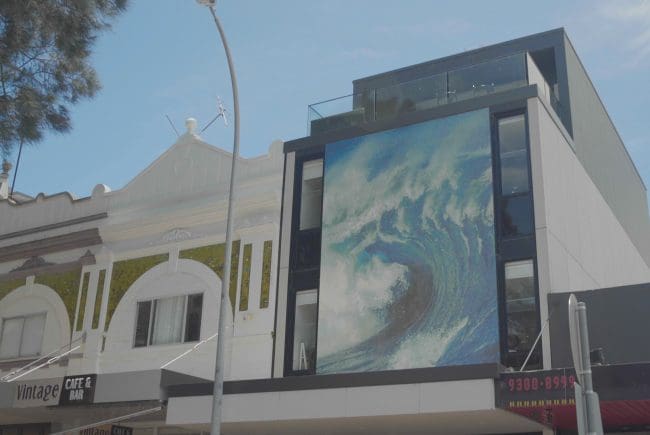Elsewhere in this post
With mortgage interest levels at an all-time low and apartment prices yet to reach the heights of a few years ago, there may never be a better time to take a plunge and invest in a property. But what .. and where? Writing for Domain in the Sydney Morning Herald, SUE WILLIAMS has some answers.
When former Sydney council officer Owen Sergeant and his wife Kerrie started thinking about buying an investment property that would have a good resale value, they found the perfect way of short-cutting the whole process.
“At the end of a meeting with my financial advisor, I asked him what he was doing with his money,” says Mr Sergeant, 65. “He then told me he’d just bought two apartments in a new development in Marrickville. So I checked them out, and they looked good – so I bought one too!”
For most of us, however, the investment decision is a little less straightforward. But, with a new CoreLogic report revealing that more than half of newly-constructed off-the-plan apartments in Sydney and Melbourne were worth less than the owners bought them for, it’s never been more important to get it right.
HOW MUCH SHOULD YOU PAY?
The first mistake most people make is thinking they should pay less than what the property they live in is worth, advises Mr Sergeant, who bought a two-bedroom fifth-floor apartment in the Mirvac development Marrick + Co in Marrickville for $1.2 million, when his own house in the Blue Mountains is valued at considerably less.
“I live here because I like the area, but an investment property is there to make money for you in the future. And the better the apartment, the better the return is likely to be.”
That’s a view that’s shared by Scott Kuru, the co-founder of Freedom Property Investors, who has accumulated 13 investment properties in six years. He believes that often people budget and try to save money on a new investment apartment, when they should be stretching themselves to buy the very best they can.
“If you can afford to buy into an iconic building like Central Park or in Barangaroo, or a penthouse or sub penthouse, that’s what you should be doing,” he says. “In the next four years, four million baby boomers will be downsizing and looking for quality property.
“There’s also the investors from China and India and America who are looking for renowned, globally iconic buildings or bigger apartments. With so many more potential buyers, the resale value is always going to be higher.”
WHERE SHOULD YOU BUY?
Location is as important as it’s ever been, and the joy of an apartment is living close to amenities like parks, beaches or waterways, schools, work, public transport and cafes, restaurants and bars.
“You should also choose an area that has a limited supply of new apartments because there’s then less competition when you come to re-sell,” says Tim Rees, senior director of residential projects in Sydney with CBRE.
Marrickville appealed to Mr Sergeant, for instance, precisely because of its lack of cranes on the skyline and a local council very strict on new development as well as its popularity and potential for further price growth.
It’s important too to check the neighbourhood. “You have to check on future projects nearby,” says real estate author and buyers agent Patrick Bright, director of EPS Property Search. “I’ve seen many developments where a development next door takes the view.”
And while transport links are important, you don’t want to be too close to them, warns Anna Porter, property valuer and principal of property advisors Suburbanite. “There can be problems if you’re too close to a train station, as it might attract riff-raff or kids hanging around and there might be vandalism or cars being broken into.”
WHAT KIND OF BUILDING SHOULD YOU BUY IN?
It can be wise to favour smaller buildings over big – unless there are great views or something special about the high rise.
“In a big building, you might always have three or four apartments for sale at the same time, and then it becomes a race to the bottom on price,” says Mr Bright.
Owner-occupiers also tend to favour smaller buildings, Mr Rees adds. “They also tend to choose apartments by a developer with a strong reputation and with higher quality. They like entry lobbies too that look higher quality – that’s much more important these days – and that look good on the ground plane with nice gardens.”
The building shouldn’t have too many facilities like pools and spas and gyms which can frighten people off with the spectre of larger strata levies, advises Ms Porter. “But it should have parking. With more and more cars on the road, more congestion and less street parking, that’s very important.”
Before buying, you should check that the strata levies look right for the building, and not artificially low for the beginning period when it still has warranties disguising the true cost of running the place, Mr Bright counsels.
And in this day and age of inflammable cladding and cracking construction, the developer and builder’s past record should also be checked. Mr Sergeant even asked for a certificate to confirm the cladding had a good fire rating and looked into the certifier.
WHAT KIND OF APARTMENT SHOULD YOU CHOOSE?
Ideally, there should be something a little different about your apartment, something that gives it a unique selling point. That might be size or a view, or having a courtyard or bigger outdoor area. “The lack of supply of those kinds of apartments will stand you in good stead,” says Mr Bright.
While the apartment should stand out from the others, it shouldn’t be too quirky. “Those different features should still give it broad appeal,” says Ms Porter. “Not everyone will appreciate an unusual-shaped study, so it still has to be attractive to the most number of buyers, and having plenty of natural light is essential.”
Bigger, well-designed apartments tend to appeal to downsizers as well as other buyers. “Baby boomers in particular want space,” says Mr Kuru. “But then if a building has had a good architect and the apartments are well laid-out and designed, a 90sqm apartment can feel like 120sqm, and the reverse is true with a bad layout.
“You’ll always get a premium for views, too. If you’re choosing between three or four apartments, spend a little more for a view. That will command a premium.”
And buy something you like, that others will too. “If you fall in love with something like a view,” says Mr Rees, “then chances are that, when it comes to your resale, someone else will fall in love with it too.”





This is now being discussed in the Flat Chat Forum